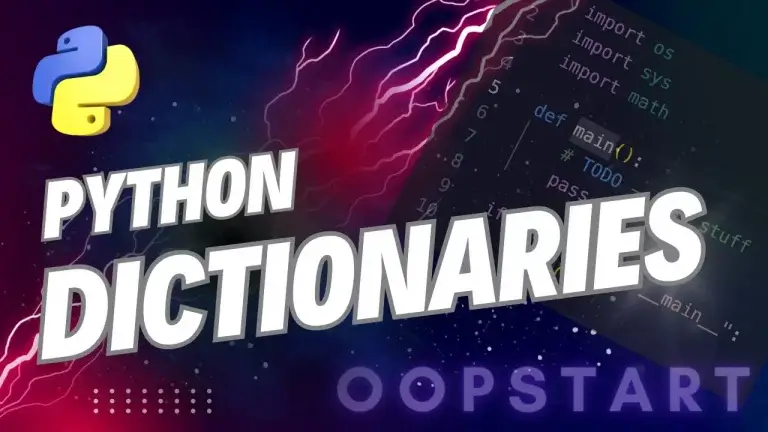Python Tuples and Dictionaries
Like Python lists, tuples and dictionaries allow you to store multiple values in a single variable, but each has its own unique properties and uses. You’ll learn when to use tuples and dictionaries, how to create them, and how to perform basic operations on them.
Table of Contents
Tuples
What is a Tuple?
A tuple is similar to a list in that it can hold multiple items, but tuples are immutable, meaning that once a tuple is created, its values cannot be changed, added to, or removed. Tuples are often used to store data that should not be modified throughout the program.
Creating a Tuple:
Tuples are created by placing values inside parentheses () and separating them with commas.
# A tuple of integers
coordinates = (10, 20)
# A tuple of mixed data types
person = ("Alice", 25, "New York")
# A tuple with one element (requires a trailing comma)
single_element_tuple = (5,)
You can also create a tuple without parentheses, simply by separating values with commas:
coordinates = 10, 20
Accessing Tuple Elements:
You can access tuple elements using indexing and slicing (like lists).
The indexing starts at 0, and negative indexing starts from -1.
coordinates = (10, 20, 30)
# Access the first element
print(coordinates[0]) # Output: 10
# Access the last element
print(coordinates[-1]) # Output: 30
# Slicing a tuple
print(coordinates[1:3]) # Output: (20, 30)
Why Use Tuples Instead of Lists?
- Immutability: Tuples are immutable, making them safer when you don’t want the data to be changed accidentally.
- Performance: Tuples can be slightly faster than lists due to their immutability.
- Key Use Cases: Use tuples when you want to store data that shouldn’t change, such as coordinates, fixed values, or configuration settings.
Tuple Methods
Tuples support only a few methods due to their immutability. The most common ones are:
count(): Returns the number of times a specified value appears in the tuple.index(): Returns the index of the first occurrence of a specified value.
Example:
numbers = (1, 2, 3, 1, 2, 1)
# Count how many times '1' appears in the tuple
print(numbers.count(1)) # Output: 3
# Find the index of the first occurrence of '2'
print(numbers.index(2)) # Output: 1
Unpacking Tuples
Tuple unpacking allows you to assign the values of a tuple to individual variables.
Example:
coordinates = (10, 20)
# Unpacking the tuple into two variables
x, y = coordinates
print(x) # Output: 10
print(y) # Output: 20
You can also use the * operator to gather remaining values into a list when unpacking:
numbers = (1, 2, 3, 4)
a, b, *rest = numbers
print(a, b) # Output: 1 2
print(rest) # Output: [3, 4]
Dictionaries
What is a Dictionary?
A dictionary is a collection of key-value pairs. Each key in a dictionary is unique, and it is used to access its corresponding value. Unlike lists and tuples, which are indexed by position, dictionaries are indexed by keys. Dictionaries are mutable, so you can change, add, and remove items.
Creating a Dictionary:
Dictionaries are created using curly braces {}, with key-value pairs separated by colons :.
# A dictionary with string keys and values
person = {
"name": "Alice",
"age": 25,
"city": "New York"
}
# A dictionary with mixed data types
inventory = {
"apples": 10,
"bananas": 5,
"price_per_apple": 0.5
}
Accessing Dictionary Values:
You can access dictionary values using the keys. If the key does not exist, Python will raise a KeyError, unless you use the get() method.
person = {"name": "Alice", "age": 25}
# Access the value of the "name" key
print(person["name"]) # Output: Alice
# Using the get() method to avoid KeyError
print(person.get("city", "Not found")) # Output: Not found
Adding or Updating Dictionary Items:
You can add a new key-value pair or update an existing key’s value by assigning a value to the key.
person["city"] = "New York" # Add a new key-value pair
person["age"] = 26 # Update the existing "age" value
print(person) # Output: {'name': 'Alice', 'age': 26, 'city': 'New York'}
Removing Dictionary Items:
There are several ways to remove items from a dictionary:
pop(key): Removes the key-value pair associated with the key and returns the value.del dictionary[key]: Deletes the key-value pair for the given key.popitem(): Removes and returns the last inserted key-value pair.clear(): Removes all items from the dictionary.
person = {"name": "Alice", "age": 25, "city": "New York"}
# Remove the "age" key
age = person.pop("age")
print(age) # Output: 25
print(person) # Output: {'name': 'Alice', 'city': 'New York'}
# Remove all items
person.clear()
print(person) # Output: {}
Dictionary Methods
Dictionaries have many useful methods to work with keys and values:
| Method | Description | Example |
|---|---|---|
keys() | Returns a view object with all the keys | person.keys() |
values() | Returns a view object with all the values | person.values() |
items() | Returns a view object with all key-value pairs | person.items() |
update(dict2) | Updates the dictionary with key-value pairs from another dictionary | person.update({"age": 30}) |
get(key, default) | Returns the value for the specified key, or default if the key doesn’t exist | person.get("city", "Unknown") |
Example:
person = {"name": "Alice", "age": 25, "city": "New York"}
# Get all keys
print(person.keys()) # Output: dict_keys(['name', 'age', 'city'])
# Get all values
print(person.values()) # Output: dict_values(['Alice', 25, 'New York'])
# Get all key-value pairs
print(person.items()) # Output: dict_items([('name', 'Alice'), ('age', 25), ('city', 'New York')])
Iterating Over Dictionaries
You can iterate over a dictionary’s keys, values, or both using loops.
Example:
person = {"name": "Alice", "age": 25, "city": "New York"}
# Iterating over keys
for key in person:
print(key)
# Iterating over values
for value in person.values():
print(value)
# Iterating over key-value pairs
for key, value in person.items():
print(f"{key}: {value}")
Checking if a Key Exists in a Dictionary
You can use the in keyword to check if a key exists in a dictionary.
person = {"name": "Alice", "age": 25}
if "name" in person:
print("The 'name' key exists in the dictionary")
Example: Building a Simple Program
Let’s build a simple program that stores information about a student (name, age, and courses) using a dictionary, and allows the user to update the student’s data.
Student Information Program:
# Create a dictionary for student information
student = {
"name": "John",
"age": 20,
"courses": ["Math", "Science"]
}
# Update student's age and add a new course
student["age"] = 21
student["courses"].append("English")
# Display the updated student information
print(student)
How it works:
- The program creates a dictionary to store the student’s name, age, and courses.
- The student’s age is updated, and a new course is added to the list of courses.
- The updated dictionary is printed.
Key Concepts Recap
- Tuples are immutable sequences of elements. You can access and slice tuple elements but cannot modify them.
- Dictionaries store data in key-value pairs. They are mutable, meaning you can add, update, or remove items.
- Dictionary methods like
keys(),values(),items(),pop(), andget()allow you to manipulate and access data efficiently.
Exercises
- Create a tuple that contains your name, age, and city. Access the second element using indexing.
- Write a program that stores a dictionary of three different books, each with a title and an author. Print the titles and authors using a loop.
- Create a dictionary to represent a grocery list, where the keys are the items and the values are the quantities. Add a new item to the dictionary and update the quantity of an existing item.
- Create a tuple of numbers, and use a loop to print the square of each number.
Next time, we’ll cover Sets and Working with Files in Python, which will allow you to handle unique collections and external data sources.
FAQ
Q1: When should I use a tuple instead of a list, what’s the difference?
A1:
- Use a tuple when you want to store immutable data — data that should not change throughout the life of the program. Tuples are often used to group related pieces of information together, such as geographic coordinates, RGB color values, or constant settings.
- Use a list when you need a collection of items that may change, such as adding, removing, or modifying elements. Lists are ideal for data that evolves over time, like a to-do list, shopping cart, or sequence of numbers.
If you find yourself needing to change elements, a list is the better choice. If immutability provides better safety (such as protecting fixed data from accidental changes), use a tuple.
Q2: Can a dictionary have two keys that map to the same value?
A2:
Yes. Each key in a dictionary must be unique, but the values associated with those keys do not need to be unique.
Example:
grades = {"Alice": "A", "Bob": "A", "Charlie": "B"}
In this case, both "Alice" and "Bob" map to the value "A". The keys ("Alice", "Bob", and "Charlie") remain unique, but the values can be duplicated.
Q3: How do tuples work with functions? Can I return multiple values from a function using a tuple?
A3:
Yes, in fact tuples are often used for this purpose. You do it like this:
def calculate(a, b):
sum_result = a + b
product_result = a * b
return sum_result, product_result
result = calculate(3, 4)
print(result) # Output: (7, 12)
# Unpacking the tuple
sum_value, product_value = calculate(3, 4)
print(sum_value) # Output: 7
print(product_value) # Output: 12
This allows you to return and handle multiple pieces of data in a structured way without needing to create a custom data structure.
Q4: Can I create a dictionary where the values are lists or tuples?
A4:
Yes, dictionaries in Python can store any type of value, including lists, tuples – even other dictionaries. This makes dictionaries flexible for storing complex data structures.
Example:
students = {
"Alice": [90, 85, 88],
"Bob": [78, 82, 80],
"Charlie": [95, 90, 92]
}
# Accessing a value (list of grades)
print(students["Alice"]) # Output: [90, 85, 88]
In this example, the dictionary students maps each student’s name to a list of grades. You can also nest tuples or dictionaries as values.
Q5: Can dictionary keys be tuples?
A5:
Yes, as long as the tuple itself contains only immutable elements (e.g., numbers, strings, or other tuples).
Example:
coordinates = {
(10, 20): "Point A",
(30, 40): "Point B"
}
# Accessing a value using a tuple key
print(coordinates[(10, 20)]) # Output: Point A
This is useful when working with data that needs to be referenced by multiple attributes (e.g., a grid or map).
Q6: Why is it necessary for dictionary keys to be immutable?
A6:
Dictionary keys must be immutable because they are used as hashes in Python’s internal workings. A hash is a unique identifier generated by Python for each key, which is used to quickly locate the corresponding value. If a key were mutable (such as a list), its hash could change after it is used, leading to inconsistency and errors when trying to retrieve values.
Immutable types like strings, numbers, and tuples are stable, meaning their hash values won’t change, ensuring that dictionaries can efficiently store and retrieve key-value pairs.
Q7: What’s the difference between a shallow copy and a deep copy when copying dictionaries?
A7:
A shallow copy only copies the top-level structure of the dictionary, meaning that if any values in the dictionary are mutable objects (like lists or dictionaries), changes to those objects will affect both the original and the copied dictionary. You can create a shallow copy using the copy() method.
Example:
original = {"a": [1, 2, 3]}
shallow_copy = original.copy()
shallow_copy["a"].append(4)
print(original) # Output: {'a': [1, 2, 3, 4]}
A deep copy copies the dictionary and all nested objects (like lists or other dictionaries) so that changes to the deep-copied dictionary do not affect the original. You can create a deep copy using the copy module.
Example:
import copy
deep_copy = copy.deepcopy(original)
Use a deep copy when you want to ensure that changes to nested objects in the copied dictionary do not affect the original.
Q8: How do I sort the keys or values in a dictionary?
A8:
Dictionaries themselves are unordered, but you can sort their keys or values using Python’s built-in sorted() function. The sorted() function returns a sorted list of keys, values, or key-value pairs.
To sort dictionary keys:
my_dict = {"b": 2, "a": 1, "c": 3}
sorted_keys = sorted(my_dict.keys())
print(sorted_keys) # Output: ['a', 'b', 'c']
To sort dictionary values:
sorted_values = sorted(my_dict.values())
print(sorted_values) # Output: [1, 2, 3]
You can also sort key-value pairs based on values:
sorted_items = sorted(my_dict.items(), key=lambda item: item[1])
print(sorted_items) # Output: [('a', 1), ('b', 2), ('c', 3)]
This will sort the dictionary by the values in ascending order.
Q9: What happens if I try to access a key that doesn’t exist in a dictionary?
A9:
If you try to access a key that doesn’t exist using bracket notation ([]), Python will raise a KeyError. To avoid this error, you can use the get() method, which allows you to provide a default value if the key doesn’t exist.
Example:
my_dict = {"name": "Alice", "age": 25}
# Using bracket notation raises a KeyError if the key is missing
# print(my_dict["city"]) # KeyError: 'city'
# Using get() returns a default value if the key is missing
city = my_dict.get("city", "Unknown")
print(city) # Output: Unknown
This is a safer way to access dictionary values when you are unsure if the key exists.
Q10: Can I use a dictionary inside a tuple, even though tuples are immutable?
A10:
Yes, you can use a dictionary inside a tuple, even though tuples are immutable. The tuple itself cannot be changed (i.e., you cannot add or remove elements from the tuple), but the dictionary inside the tuple remains mutable, meaning you can modify its contents.
Example:
my_tuple = ({"name": "Alice"}, "constant_value")
my_tuple[0]["age"] = 25 # This is allowed because the dictionary is mutable
print(my_tuple) # Output: ({'name': 'Alice', 'age': 25}, 'constant_value')
Even though the tuple structure is immutable, any mutable objects within the tuple can still be modified.
Q11: Can I use dictionary comprehension, similar to list comprehension?
A11:
Yes, Python supports dictionary comprehension, which allows you to create dictionaries in a compact, readable way, similar to list comprehension.
Example:
# Create a dictionary of squares using dictionary comprehension
squares = {x: x**2 for x in range(5)}
print(squares) # Output: {0: 0, 1: 1, 2: 4, 3: 9, 4: 16}
You can also add conditions to dictionary comprehension:
# Create a dictionary with even numbers as keys and their squares as values
even_squares = {x: x**2 for x in range(10) if x % 2 == 0}
print(even_squares) # Output: {0: 0, 2: 4, 4: 16, 6: 36, 8: 64}






